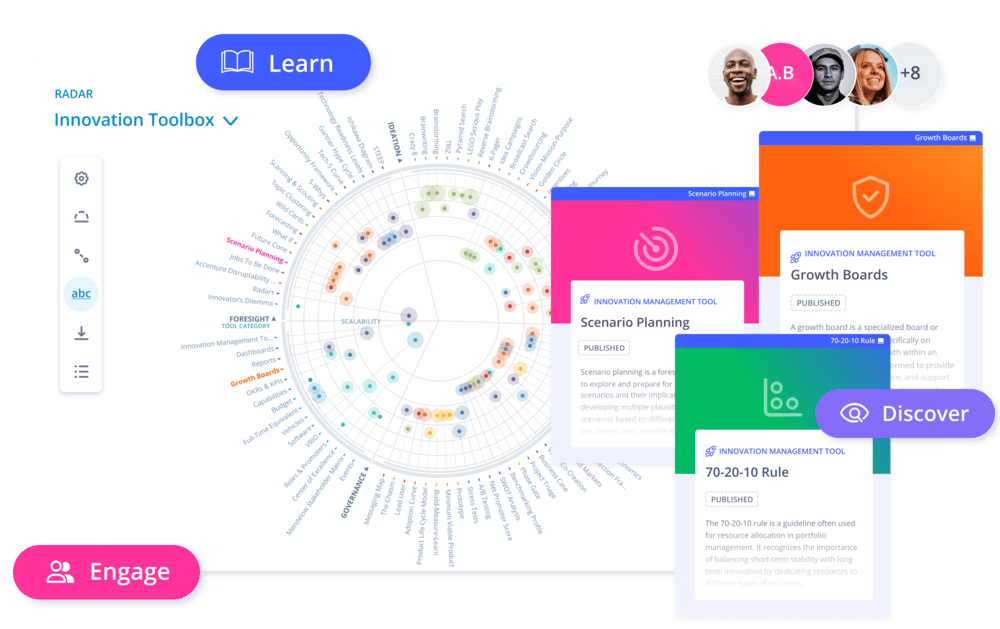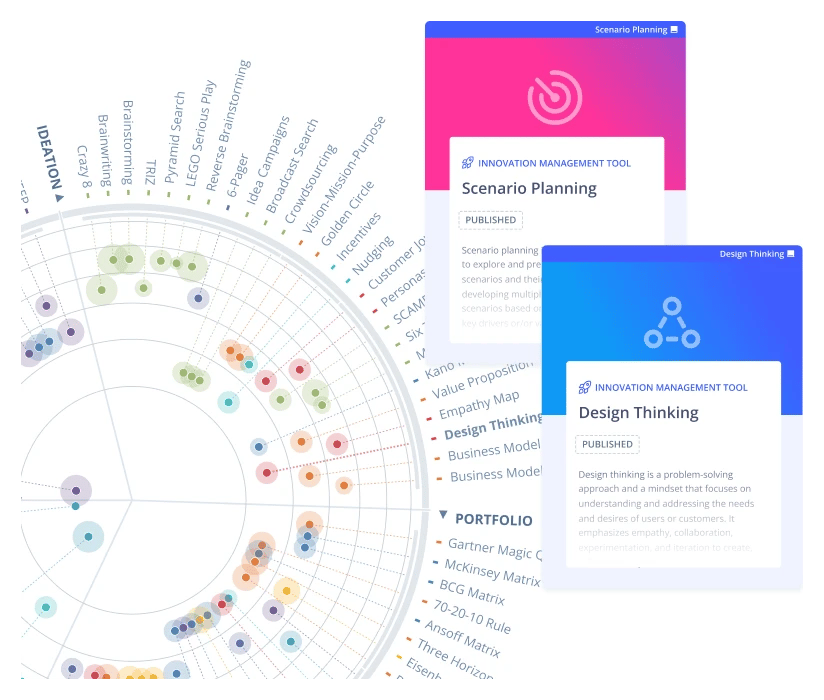
INNOVATION METHODS HUB
The ultimate innovation toolbox
Navigate through the most powerful innovation tools and techniques to supercharge your innovation management, compiled and assessed by our experts.

Explore 80+ innovation methods, techniques, and concepts
Welcome to the ultimate innovation toolbox!
This free resource hub consists of 80+ best-practice innovation methods, techniques, and concepts to help organizations operationalize end-to-end innovation, upgrade their capabilities, and drive growth systematically.
Explore the toolbox to determine the set of tools that are right for your team, use case, and objectives, and in doing so, build your organization's custom innovation management toolbox.
Below you'll find a selection of some of the most prevalent innovation management tools in the areas of foresight, ideation, innovation portfolio management, and innovation governance, together with useful templates, guides, and resources you can download for free.
To learn more about applying each tool in your end-to-end innovation journey and putting methodology into practice, get in touch with our innovation experts for a free demo.

Foresight tools and methods
Learn more about the most relevant methods and approaches for strategic and continuous foresight.
Scenario Planning
Scenario planning is a foresight method used to explore and prepare for potential future scenarios and their implications. It involves developing multiple plausible future scenarios based on different combinations of key drivers and/or variable data trajectories.
By embracing scenario planning, companies can better understand the challenges and opportunities they may face, improving their ability to adapt and succeed in a rapidly changing world.
Download our free Scenario Planning Toolkit to learn how ITONICS helps you develop and prioritize scenarios, identify innovation opportunities, and use roadmaps to integrate scenarios into your organization's strategy planning and execution.
Radars
Radars are foresight tools for monitoring and analyzing emerging technologies, trends, and other drivers of change or factors that may impact an organization's future. Radars can help organizations identify potential opportunities and threats in their external environment to help inform strategic decision-making.
A radar organizes foresight intelligence in a centralized and intuitive view. It should be set up with predefined categorization criteria that display thematic segmentation, relationships, potential value, impact, and/or maturity levels.
Use the ITONICS Radar to centralize your organization’s innovation intelligence and amplify the impact of your strategic foresight activities. The Radar allows teams to visualize and collaboratively evaluate drivers of change. You can configure and share custom Radar views to easily identify critical relationships, prioritize key ratings, and derive actionable insights for accelerating opportunity discovery.
Scanning & Scouting
Scanning and scouting are two foresight activities that organizations use to gather information about their external environment. Scanning provides the foundation by capturing a wide array of information, while scouting helps to identify emerging opportunities and trends that might not be readily apparent through scanning alone.
Often combined to create a more holistic view, scanning and scouting are essential for organizations to anticipate and respond effectively to changes in their industry and maintain a competitive edge.
Use the ITONICS Innovation OS to amplify the impact of scanning and scouting activities. With ITONICS Insights, ITONICS Radar, and other foresight tools, you can discover weak signals, emerging technologies, trends, and opportunities faster to inform strategic decision-making and prepare for disruptive change.
Opportunity Framework
An opportunity framework is a systematic approach used to identify and evaluate potential opportunities for a company. It helps in understanding the future business landscape, emerging trends, and disruptive forces that may impact the industry or market.
Organizations can use an opportunity framework for several purposes. By identifying new growth avenues and potential disruptions, it supports the development and adaptation of strategic plans. It is a common approach in new product development, market expansion, digital transformation, and risk management.
Download the Opportunity Space Canvas template to guide you through the process of visualizing key market trends and technologies, potential customers and markets, and strategic positioning—all in one comprehensive framework.
Innovator's Dilemma
The Innovator’s Dilemma is a concept coined by Clayton M. Christensen in his book titled "The Innovator's Dilemma: When New Technologies Cause Great Firms to Fail." The book explores the challenges that established companies face when dealing with disruptive innovations.
The Innovator's Dilemma arises from the conflict between the desire to maintain the status quo and the need to adapt to emerging disruptive technologies.
Use the ITONICS Technology Radar to explore and monitor disruptive technologies relevant to your business. The Technology Radar serves as a digital early-warning system in which you can invite collaborative evaluation, identify risks and opportunities, and shape your innovation strategy to overcome the Innovator's Dilemma.
Ideation tools and methods
Discover the most important methods and ideation techniques that are useful in the ideation process.
Idea Campaigns
An idea campaign is a structured approach for generating and collecting ideas from employees or external stakeholders. It involves launching a focused initiative, campaign, or challenge to solicit innovative ideas and solutions addressing a specific challenge or opportunity.
Idea campaigns, or ideation challenges, provide a structured framework to unlock participants' creative potential and generate actionable ideas. They enable organizations to tap into the collective intelligence of their stakeholders, including employees at all levels, departments, and even external stakeholders like customers or partners. By engaging diverse perspectives, idea campaigns can generate a broader range of ideas to ultimately drive innovation.
Use ITONICS Campaigns to unlock ideas through collaborative workflows. With Campaigns, you can collect, evaluate, and evolve ideas from thousands of internal or external collaborators to maximize your organization’s innovation potential.
Crowdsourcing
Crowdsourcing is an idea generation method that involves leveraging the power of a specific crowd or a defined group of individuals to contribute ideas, insights, or solutions to a problem or challenge.
Crowdsourcing goes beyond simply seeking ideas and encourages active participation, collaboration, and co-creation among participants. It can take different forms, such as innovation contests or dedicated communities where participants can submit their ideas.
Use ITONICS Open Innovation to amplify the impact of crowdsourcing efforts. With Open Innovation, you can involve clients, external experts, startups, and potential partners in generating solutions for short, mid, and long-term challenges.
Nudging
The nudging method involves using subtle and indirect prompts to influence and encourage employees to generate new ideas. It draws from the concept of behavioral economics, which suggests that individuals can be nudged towards making certain decisions or taking specific actions through gentle and non-coercive interventions.
Having a collaborative platform, gamification, feedback and recognition, notifications, and training and workshops are some of the ways the nudging method can be applied to motivate ideation within a corporate innovation program.
Download the ITONICS Campaigns Product Fact Sheet to learn how to break down silos and strengthen cross-functional cooperation with collaborative idea workflows. With ITONICS Campaigns, you can incentivize participation with gamification, nudging, and customized submission platforms.
Design Thinking
Design thinking is a problem-solving approach and a mindset that focuses on understanding and addressing the needs and desires of users or customers. It emphasizes empathy, collaboration, experimentation, and iteration to create, refine, and implement innovative solutions.
Design thinking promotes a non-linear and iterative approach, where the stages of the process are often revisited and repeated as new insights are gained. It encourages a bias towards action and learning through rapid experimentation.
Use ITONICS Campaigns to enhance design thinking outcomes by grounding the decision-making process in collaborative input and empirical evidence. With Campaigns, you can get started quickly with best-practice design thinking templates or configure your own workflows to iteratively refine ideas and generate solutions that are user-centric, impactful, and data-supported.
Brainstorming
Brainstorming is a popular ideation technique used by organizations for generating creative ideas. The purpose of brainstorming is to encourage free thinking, open discussion, and the exploration of unconventional ideas.
After the brainstorming session, generated ideas should be collated and evaluated based on predetermined criteria. A digital platform that enables collaborative rating and visualizations can help facilitate this process. The aim is to prioritize the most promising and feasible ideas that align with the objective of your innovation initiative.
Download our free How to Rate Ideas Cheat Sheet for evaluating and prioritizing the ideas generated through brainstorming. Build a collective perspective on which ideas to focus on for further refinement, feasibility, validation, and, ultimately, implementation as part of your organization’s innovation portfolio.
Innovation portfolio management tools and methods
The key methods and approaches for successful innovation portfolio management.
Phase Gate
A phase gate is a structured and sequential approach used to manage, evaluate, and execute projects at various phases of their development. The purpose of a phase-gate process is to enable effective decision-making throughout a project's life cycle.
By implementing phase gates, organizations can ensure that projects align with strategic objectives, meet predetermined criteria, and have the necessary resources to proceed. This approach reduces the risk of investing in projects that may fail to deliver the expected outcomes or align with business priorities.
Use ITONICS Ideation and Portfolio to systematically move ideas and projects forward, identify bottlenecks, and streamline delivery. With workflows in ITONICS, you can configure custom phase-gate processes, automate tasks, strengthen oversight, and ensure the efficient execution of your most critical innovation initiatives.
Roadmaps
A roadmap is a visual representation of the milestones and deliverables required to manage an organization’s transition from its current state to a future state over a specific time period. It provides a structured framework for managing and tracking the progress of initiatives within an innovation portfolio.
With greater oversight provided by roadmaps, teams can quickly match resource allocation with strategic priorities, identify synergies, and mitigate bottlenecks to streamline project delivery.
Use ITONICS Roadmap to easily build agile multi-layered roadmaps, linking foresight and ideation activities with portfolio initiatives, strategic goals, and more. You can configure a custom roadmap or select from one of ITONICS’ best-practice roadmap templates to get started quickly.
Ansoff Matrix
The Ansoff matrix is a strategic tool for analyzing and prioritizing growth strategies within an organization’s innovation portfolio. It provides a framework for evaluating various options for growth based on two dimensions: product (existing or new) and market (existing or new).
The Ansoff matrix consists of four growth strategies: market penetration, product development, market development, and diversification. It helps businesses assess their risk appetite and identify growth opportunities by considering different combinations of product and market strategies.
Use ITONICS Portfolio to operationalize the Ansoff matrix approach in your innovation program. With Portfolio, you can easily evaluate and prioritize new and existing portfolio initiatives and construct multiple matrix views to assess risks and opportunities.
70:20:10 Rule
The 70:20:10 rule is a guideline often used for resource allocation in portfolio management. It recognizes the importance of balancing short-term stability with long-term innovation by dedicating resources to different types of initiatives.
The rule promotes innovation portfolios that focus on both exploiting existing capabilities and exploring new possibilities. It suggests the following allocation of innovation resources: 70% on core business, 20% on adjacent opportunities, and 10% on transformational opportunities.
Download the ITONICS Portfolio Product Fact Sheet to learn how this tool provides the oversight and agility to easily prioritize, adapt, and allocate resources across your strategic portfolio, maximizing your return on innovation.
Build-Measure-Learn
The build-measure-learn (BML) approach is a fundamental concept in the Lean Startup methodology, which focuses on iterative and validated learning in the process of developing new products or services. The BML approach emphasizes the importance of hypothesis testing, customer feedback, and continuous improvement.
BML helps teams minimize the risk of building products or services that do not meet customer needs or have low market demand, ultimately increasing the chances of success and reducing waste in the innovation process.
Download the ITONICS Portfolio Product Fact Sheet to learn how to operationalize the BML approach in your innovation program through custom phase-gate processes, KPI tracking, and intuitive data visualizations and dashboards.
Innovation governance tools and methods
Explore our top five methods and tools for next-level innovation governance.
Software
Innovation management software helps organizations digitalize innovation activities for gains in efficiency, time and cost savings, and improved outcomes. But unlike traditional and often fragmented innovation management software, the ITONICS Innovation Operating System (OS) seamlessly connects foresight, ideation, and portfolio activities with strategic goals in one collaborative system.
ITONICS provides a one-stop innovation management software solution. Instead of using a range of different tools for your growth strategy, foresight, environmental scanning, ideation, open innovation, portfolio management, and roadmapping, the ITONICS Innovation OS is a single, integrated, and collaborative solution.
Get a free demo to learn more about how the #1 Innovation OS can upgrade your organization's end-to-end innovation capabilities for you to move from strategy to execution with speed and agility.
Dashboards
Innovation dashboards visually represent data and information that provide a concise and intuitive overview of key performance indicators (KPIs), metrics, and insights. They are designed to offer a real-time snapshot of important aspects related to an organization’s innovation program, enabling quick and informed decision-making.
Dashboards enable the tracking of key innovation metrics and KPIs, such as the number of new ideas generated, the success rate of implemented innovations, R&D expenditures, and resource allocation. By displaying strategic goals and targets alongside progress, they can help ensure innovation efforts are on track and contributing to the overall strategic direction.
Use the ITONICS Innovation OS to consolidate, track, and communicate all your innovation intelligence in one collaborative platform. With dashboards in ITONICS, you can easily configure a variety of data visualizations and charts to quickly focus on what matters most to your organization’s strategic growth.
Roles & Promoters
Defining clear roles as part of innovation governance provides a structured framework and foundation for effective coordination, efficient resource allocation, alignment, and accountability. Key roles in innovation governance may include innovation managers, cross-functional teams, a governance board or committee, and promoters.
Specifically, the promoter model recommends four distinct types of promoters: project sponsors, technology or specialist, project champion, and relationship promotor or networker. Establishing these roles within an innovation team nurtures a culture of innovation and provides the necessary support to encourage engagement and collaboration for better innovation outcomes.
Download our free Innovation Management Job Universe Poster to gain a comprehensive overview of essential roles, tasks, and milestones at each stage of the innovation journey.
Benchmarking Profile
A benchmarking profile refers to a set of standards, metrics, or performance indicators used to assess and compare the performance of a particular asset, innovation, or initiative against industry best practices or competitors. It involves measuring and evaluating various aspects of performance to identify areas of improvement, set targets, and track progress over time.
By establishing benchmarking profiles, organizations can compare the health and performance of their innovation portfolio with industry standards, previous performance, or competitors' portfolios. This allows them to identify areas where they are underperforming or falling behind, as well as areas where they excel.
Download our free Innovation Framework & KPIs White Paper to learn more about important metrics for establishing benchmarks, providing oversight, justifying innovation investments, and informing strategic decision-making.
Budget
Budgets play a vital role in innovation governance by providing a financial framework that guides resource allocation, decision-making, risk management, performance evaluation, and accountability in the pursuit of innovation within an organization.
The management of an innovation budget typically involves several key stakeholders within an organization, including leadership, innovation teams, and the finance department. It requires effective communication, analysis of resource needs, monitoring of expenses, and flexibility to adapt as the organization's innovation landscape evolves.
Download the ITONICS Portfolio Product Fact Sheet to learn how this tool aggregates budgetary information, capacities, and KPIs for agile portfolio management and strategy execution.
Free innovation tools at your fingertips


How to Rate Ideas

